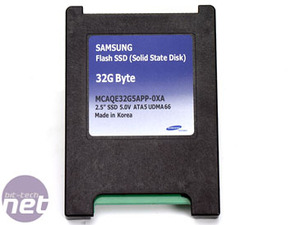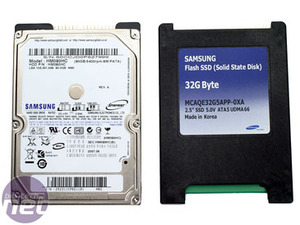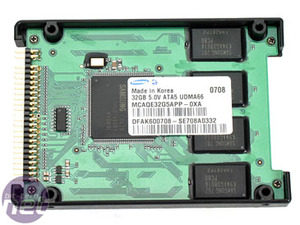
Samsung 32GB Solid State Drive
Manufacturer: SamsungPrice as reviewed (UK): £294.99 (inc. VAT)
Price as reviewed (US): $529.00 (ex. Tax)
Going back some, the invention of the spinning metal disk and moving head was a huge innovation over old(er) school tapes, bringing down random access times and increasing density and life-spans. However, it’s already been 25 years since then so we're long overdue for another monumental storage change.
The continual development of the aforementioned spinning disks has had to solider on, simply because there has been nothing else to challenge it for size, cost and reliability. During its existence the rampaging uptake of computers into just about everything, has in some respects left the humble hard drive behind: it can serve us just megabits per second rather than the gigas and teras we’re used to seeing from everything else in a PC. Its capacity and densities are ever increasing, but the performance is still the bottleneck of many systems.
Did I say reliability? Deathstar users of old will disagree. Tales of entire lives lost litter the Internets like war stories, but that’s as much to do with a good backup routine rather than a particular product fault. There’s the saying, “Don’t put all your eggs in one basket” for good reason.
Eventually as the popularity of NAND Flash has increased thanks firstly to USB memory keys and then a whole host of other applications which has brought down the price dramatically. It’s still tens of times more expensive per gigabyte than a normal hard drive, but it offers an unparalleled access time and random read performance which a normal hard drive just can’t match. Add this to the fact they are perfectly silent, emit very little heat, are capable of being "instant on" and being shock and drop proof and you have a perfect alternative to the classic hard drive, especially in mobile devices. Straight read speeds still can’t quite match the latest hard drives but a striped RAID array should offer a far greater linear performance increment, due to the way data is directly and instantly addressed on an SSD.
Despite solid state devices offering a greater reliability because of no moving parts, NAND Flash suffers from wear of use and actually loses the ability to record data after a certain number of writes. That amount is into the many millions but that hasn’t stopped people in the past trying to use large Compact Flash cards as a dedicated pagefile drive and having them die within a day. The pagefile (swap in Linux) is constantly read and written to in Windows and is ideally suited to a high I/O device like Flash, however after several million read/writes to the same area it will fail.

SSD producers have got around this by constantly varying where the bits are written to. Because there is no random read penalty since anywhere on the Flash device can be read at any time, it makes no difference where the bits are thrown. It also means you’ve no more requirement to defragment your drive either.
But does the sacrifice of size and cost per gigabyte warrant the expenditure over a bigger traditional disk? Will the benefits of Flash make games, OS boot times and general productivity higher or have we had the traditional hard disk for so long everything is now so inherently developed around it to compensate for its shortcomings?
Samsung sent us its MCAQE32G5APP-0XA Solid State Drive: a 32GB 2.5” notebook drive on a parallel ATA interface that weighs just 51g. We are told that SATA versions of the drive are right around the corner, but right now we’re limited to the older IDE interface.
The SSD could be only slightly thicker than the width of the PCB if it weren’t for the need to actually conform to the size of a typical 2.5” drive. Instead it’s screwed to a moulded piece of plastic to bulk it out a bit. It could be a perfect fit for a mod that needs storage in a low profile environment since it produces very little heat compared to a standard 2.5" notebook hard drive.
Sixteen 2GB chips make up the 32GB SSD, so the cost of making it really stacks up if you think a fast 2GB USB Flash drive is about £20 (inc. VAT), so you’re already looking at £320 in Flash alone. Obviously there are economies of scale for Samsung as it makes the raw Flash and controller chip, but we’re very far out of normal hard drive pricing considering you can buy over fifteen times the capacity for a fifth of the price.
32GB can still fit quite a lot on, after all you can install
Finally, a Samsung SSD can work in extreme environments, withstanding 1000Gs of gravitational shock, unlike a hard drive which can only take around 70Gs when operational. It can also be used between -25ºC and +85ºC, rather than the more limited +5ºC to 60ºC for a normal hard drive.

MSI MPG Velox 100R Chassis Review
October 14 2021 | 15:04












Want to comment? Please log in.